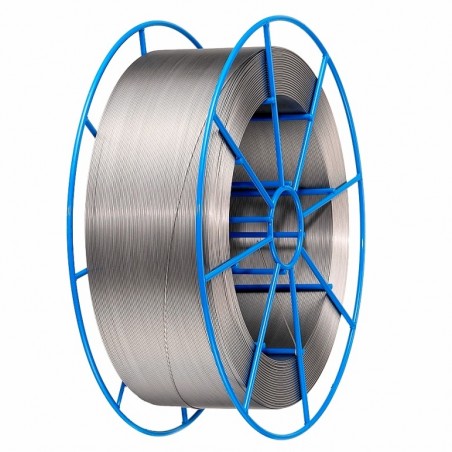
Stainless steel MIG welding wire 316LSi - Ø 1 mm - V4A -1.4430, 5.00Kg 800...
Réf : 0010624

In MIG welding, the solid stainless steel wire is used as a filler material or welding wire: It's employed for joining thick stainless steel parts, thus suitable for filling. The 308LSi stainless steel is corrosion-resistant.
The MIG technique, an acronym for Metal Inert Gas, is renowned in the welding world for its exceptional speed and efficiency. This arc welding method with a fusible wire stands out for its ease of use, while requiring specific technical expertise. It is characterized by the use of a continuous, automatically fed filler wire, which facilitates smooth and consistent welding, essential for extensive welding tasks.
The core of the MIG process lies in creating a protective gas atmosphere surrounding the welding point, thereby preventing any contamination from the ambient air. This gas shield is crucial for achieving clean welds, free from slag inclusions. The effectiveness of the MIG process is particularly evident when joining non-ferrous metals such as aluminum, copper, or stainless steel, where it ensures joints with excellent structural integrity.The MIG technique, an acronym for Metal Inert Gas, is renowned in the welding world for its exceptional speed and efficiency. This arc welding method with a fusible wire stands out for its ease of use, while requiring specific technical expertise. It is characterized by the use of a continuous, automatically fed filler wire, which facilitates smooth and consistent welding, essential for extensive welding tasks.
The core of the MIG process lies in creating a protective gas atmosphere surrounding the welding point, thereby preventing any contamination from the ambient air. This gas shield is crucial for achieving clean welds, free from slag inclusions. The effectiveness of the MIG process is particularly evident when joining non-ferrous metals such as aluminum, copper, or stainless steel, where it ensures joints with excellent structural integrity.
Stainless steel MIG welding wire 316LSi - Ø 1 mm - V4A -1.4430, 5.00Kg 800...
Réf : 0010624
Stainless steel MIG welding wire 308LSi - Ø 1 mm - V2A - 1.4316, 15.00Kg 2400...
Réf : 0008905
Stainless steel TIG welding wire 1.4316 - Ø 1.6 mm - 308LSi Stainless steel...
Réf : 0011405